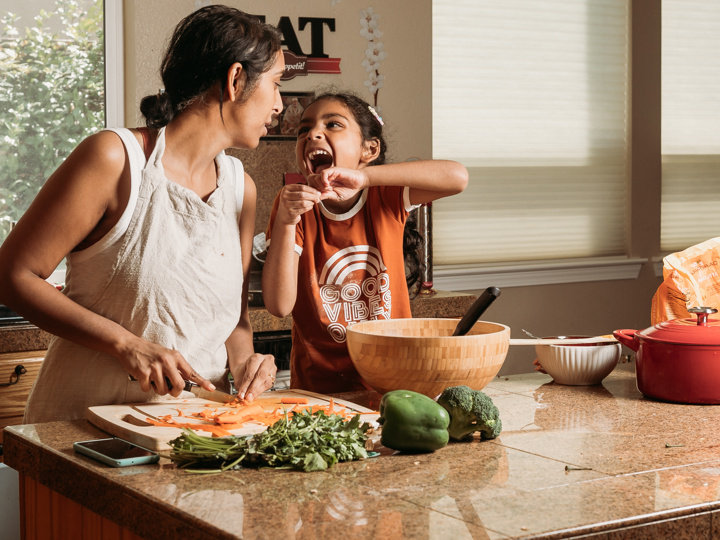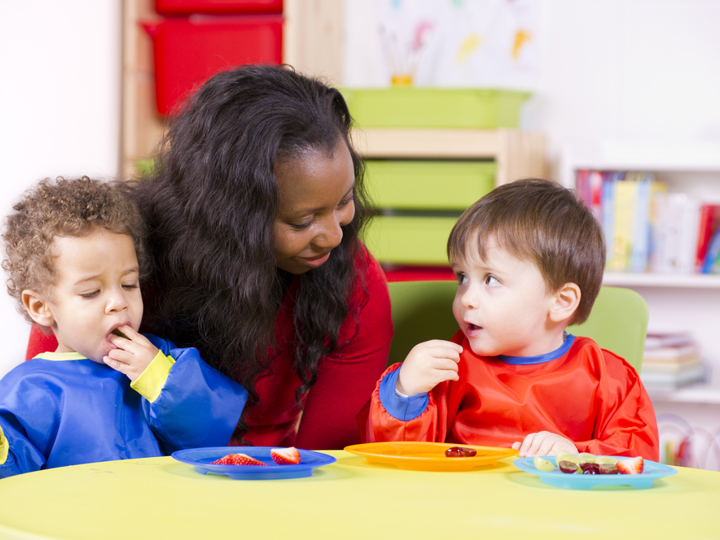Creating good mealtime routines

Having a clear and consistent mealtime routine is important for children. Mealtime routines can help:
- your child know what is coming next
- develop regular eating patterns
- you manage transitions from other activities to mealtimes
The importance of mealtime routines
Questions to ask yourself when setting up a mealtime routine
It can be helpful to think about some of the following questions when setting up a routine. Even if you already have a routine in place around meals and snacks, it can still help to think about these questions.
- How have you spoken about the mealtime routine with your child? Do you think they know when they will be offered food during the day?
- How do you involve your child during mealtimes? Do they set the table, prepare food or clear away plates and cups?
- How do you alert your child that a mealtime is starting? Do they have to sit at a table?
- Do you have distractions at mealtimes such as TV, toys or tablets?
- How will you build in activities that will help regulate your child before a mealtime? Is it enough just to involve them in the mealtime routine, or do they need structured sensory activities?
- How are you going to manage unwanted behaviour at mealtimes? What type of behaviour is unacceptable? How will you respond to unacceptable behaviour?
When planning your mealtime routine, it can be helpful to think about activities that you or your child will do before, during and after a meal.
- Try to limit snacks. Make sure you limit snacks 30 to 60 minutes before a meal.
- Encourage your child to move throughout the day. It does not have to be a specific exercise. Activities could include playing catch, walking, skipping or playing at a park. Read more about moving and being active.
- Encourage your child to help you plan meals. If you have a list of meals you regularly make for your family, your child can pick some of the meals for the week.
- Encourage your child to help you prepare the food. Under your supervision, they can help you prepare food. This could be washing vegetables in the sink or helping weigh the food.
- Encourage your child to help prepare for the mealtime. This might include setting the table, making drinks or clearing away toys.
- Think about your child's sitting position at the table. Their knees, hips and elbows should all be at 90 degrees. Read more about posture and sitting positions.
- Try to reduce distractions at mealtime. Make sure the TV is turned off and that there are no toys at the table.
- Try to create a low-stress environment. This will help reduce anxiety at mealtimes.
- Act as a role model for your child. Children learn by watching adults behaviour and actions. There are various ways you can do this at mealtimes, such as:
-
- sharing meals together as often as possible
- eating meals at a table
- Encourage good behaviour during meals. Think about what is important to your family. This will be unique to each family. Try to consistently reinforce and encourage this behaviour.
- Gently encourage your child to try new foods.
- Offer food that you know your child likes, these are also known as safe foods. This can help to reduce their anxiety at mealtime. It can also protect the progress and growth your child has made.
- Talk about the food you are eating. For example, you can talk about the how the food looks, the colour, the taste or the texture.
- Allow your child to leave the table when they have finished eating.
- Talk about their experience with the food. You can ask them about what they liked and didn't like.
- Use a diary of food exposure. You can try writing down what types of food your child will and won't eat. You can also record what time of the day and where they are.
Using a picture board to help your child make food choices
You can use a picture board to help your child choose what they want without feeling pressured. They can point to a picture of the food they want. Picture boards can be used at mealtimes but also at other times during the day.
- Write down all the foods your child likes to eat for meals and snacks.
- Find pictures of these foods, cut out packaging, or use words (depending on what your child understands). Stick these onto a piece of cardboard using blue tack, Velcro, or anything that lets you attach and remove them easily.
- Choose up to 5 items. Some children might prefer only 2 to 3 items to avoid feeling overwhelmed.
- Before each mealtime or snack, show your child the board and let them choose what they want to eat. They can point or say what they want and then take the picture off the board to give to you. Once a food is chosen, it doesn’t go back on the board for the rest of the day.
- Only put foods on the board that are available to keep your child confident in using the board and avoid disappointment.
Last reviewed: 1 November, 2024

